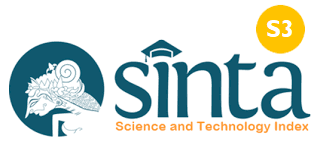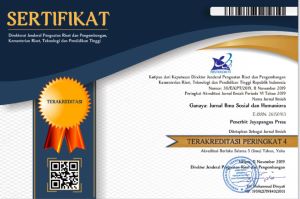Transformasi Kreativitas Kidung Jerum Dalam Novel Jerum Sebagai Sastra Kontemporer
DOI:
https://doi.org/10.37329/ganaya.v8i1.3834Keywords:
Kidung Jerum, Novel Jerum, Adaptation, Intertextuality, Contemporary LiteratureAbstract
Kidung Jerum as part of Balinese literature has developed widely with its function as a medium for ceremonies, especially bhuta yadnya. In the midst of its popularity, the story of Kidung Jerum is not widely known by the general public because in the process of singing it only a few verses are taken. As an effort to popularize the story of Kidung Jerum to a wider area, a media conversion was carried out. The process of converting Kidung Jerum into the Jerum novel is a creative process that can expand the scope of reading traditional literary works. In the form of a novel, the story of Ni Jerum and Kundangdia has a wider target audience both locally and nationally. This change in form is something interesting that is important to study in a study, whether the Jerum novel immediately imitates Kidung Jerum, is there a creative process in the form of character and story expansion, is the ideology in the kidung also inherited into the novel? Of course, all these questions will be answered in the discussion of this study. The purpose of this study is to reveal the extent to which the Jerum novel is dependent on adapting the story of Kidung Jerum. In this study, the theory used is intertextual theory. The method used to support this research is the comparative method. This method is done by carefully reading both works and comparing them to see how the transfer of ideology from kidung into the novel. The results of this study show the sustainability of the construction of the network structure that forms kidung Jerum in the novel Jerum, secondly, the transformation of the main motifs of kidung Jerum (hypogram) into the novel Jerum (apogram) in the form of the motif of the command to marry, the motif of the emergence and acceptance of love, the motif of post-death, the motif of revenge, the motif of life again.
References
Abrams, M. H. (1957). A glossary of Literary Terms. New York: Holt, Rinehart and Winston, Inc.
Artawan, G. (2017). Intertextuality of Balinese Writers Works in Comprehending Tradition (Reinterpretation, Reconstruction, and Cultural Response). International Research Journal of Management, 4(3), 51-60.
Asteka, P. (2017). Kajian Intertekstualitas Dalam Novel Siti Nurbaya Karya Marah Rusli Dan Laila Majnun Karya Syaikh. Bahtera Indonesia: Jurnal Penelitian Bahasa Dan Sastra Indonesia, 2(2), 13-21.
Barthes, R. (2024). Kritik Dan Kebenaran: Analisis Kritik Wacana. Bandung: IRCiSoD.
Bali, P. P. N. S. K. D. (1985). Kidung Jerum Kundangdia. Denpasar: Percetakan Bali.
Cao, L. (2022). The Mirror And The Lamp: From The Classical Mimetic To The Romantic Expressive. Foreign Literature Studies, 44(6), 152.
Cika, I. W., Madia, I. M., & Arnati, N. W. (2021). Narasi Berubah Pesan Moral Tetap: Transformasi Teks Bhagawan Domya ke dalam Cerita Sang Eka Jala Resi. Jurnal Kajian Bali (Journal of Bali Studies), 11(1), 131-146.
Creese, H. (2012). Perempuan Dalam Dunia Kakawin: Perkawinan Dan Seksualitas Di Istana Indic Jawa Dan Bali. Denpasar: Pustaka Larasan.
Damono, S. D. (2023). Alih Wahana. Jakarta: Gramedia.
Damono, S. D. (2013). Sosiologi Sastra. Jakarta: Editum.
Darmayanti, I. (2014). Seksualitas Perempuan Bali dalam Hegemoni Kasta: Kajian Kritik Sastra Feminis pada Dua Novel Karangan Oka Rusmini. Jurnal Ilmu Sosial Dan Humaniora, 3(2), 484-494.
Harini, Y. N. A. (2016). Transformasi Folklor Lisan Nini Anteh Ke Novel Dongeng Nini Anteh Karya A.S. Kesuma. Jurnal Pendidikan Bahasa Dan Sastra, 12(2), 56-70.
Imani, A. H., & Darni, D. (2022). Transformasi Teks Kidung Wangbang Wideya dalam Fragmen Topeng Sekartaji (Kajian Alih Wahana). JOB: (Jurnal Online Baradha), 18(2), 549-567.
Juliana, I. W. (2021). Kidung Bhramara Sangupati Analisis Semiotik. Widyacarya: Jurnal Pendidikan, Agama Dan Budaya, 5(2), 168-174.
Luxemburg, J. V., Bal, M., Willem, G. W. (1984). Pengantar Ilmu Sastra. Jakarta: PT Gramedia.
Octafiona, E. (2024). Kajian Intertekstualitas Dalam Sastra Indonesia Kontemporer. Edu Cendikia: Jurnal Ilmiah Kependidikan, 4(2), 645-655.
Pradotokusumo, P. S. (1986). Kakawin Gajah Mada Sebuah Sastra Kakawin Abad ke-20: Suntingan Naskah Serta Telaah Struktur, Tokoh, dan Hubungan Intertekstual. Yogyakarta: Universitas Gajah Mada Press.
Putra, I. N. D. (2021). Heterogenitas Sastra Di Bali. Denpasar: Pustaka Larasan.
Riffaterre, M. (1978). Semiotics of Poetry. Bloomington: Indiana University Press.
Rusmini, I. A. O. (2020). Jerum (Novel). Denpasar: Prasasti.
Suarka, I. N. (2007). Kidung Tantri Pisacarana. Denpasar: Pustaka Larasan.
Teeuw, A. (2013). Sastra dan Ilmu Sastra, Pengantar Ilmu Sastra. Jakarta: Pustaka Jaya.
Todorov, T. (2012). Dasar-dasar Intertekstualitas:Pergulatan Mikhail Bakthin Menuju Teori Sastra Terpadu. Denpasar: Cv Bali Media Adhikarya.
Wellek, R., & Werren, A. (1989). Teori Kesusastraan. Jakarta: Gramedia.
Downloads
Published
How to Cite
Issue
Section
License
Copyright (c) 2025 I Wayan Juliana (Author)

This work is licensed under a Creative Commons Attribution-ShareAlike 4.0 International License.
An author who publishes in the Ganaya : Jurnal Ilmu Sosial dan Humaniora agrees to the following terms:
- Author retains the copyright and grants the journal the right of first publication of the work simultaneously licensed under the Creative Commons Attribution-ShareAlike 4.0 License that allows others to share the work with an acknowledgement of the work's authorship and initial publication in this journal
- Author is able to enter into separate, additional contractual arrangements for the non-exclusive distribution of the journal's published version of the work (e.g., post it to an institutional repository or publish it in a book) with the acknowledgement of its initial publication in this journal.
- Author is permitted and encouraged to post his/her work online (e.g., in institutional repositories or on their website) prior to and during the submission process, as it can lead to productive exchanges, as well as earlier and greater citation of the published work (See The Effect of Open Access).
Read more about the Creative Commons Attribution-ShareAlike 4.0 Licence here: https://creativecommons.org/licenses/by-sa/4.0/.








